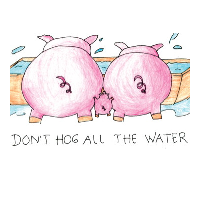How Does Personal Water Conservation Help When BigAg Is Using Most of It?

When Governor Jerry Brown declared a drought state of emergency in January, he touted California’s public awareness campaign, Save Our Water, which educates residents about what they need to know to make intelligent decisions about conserving this endangered resource, and listed 20 measures he “hereby ordered.”
They included an implied threat to make Californians reduce their water consumption by 20%. That can be painful and expensive. The sole mention of agricultural interests was a promise to hook them up with state agencies to manage their water needs.
And those water needs are enormous. They dwarf the meager consumption of California’s 38 million residents.
BigAg’s take of the state’s water supply has been variously calculated at between 79% (by state government) and 93%. A 2012 report (pdf) from the Pacific Institute opted for the higher number, and contrasts it with 4% for household consumption and 3% for industry. That information is not considered relevant to the discussion at Save Our Water, where consumers can calculate their water use at home and take the “Californians-Don’t-Waste Challenge.”
It’s a challenge, perhaps, better suited for farmers. The Pacific Institute report calculated that half the state’s water usage went to producing goods and services for export, and “this virtual water export is likely a reflection of the role California’s agricultural industry plays in supplying a significant portion of the nation’s fruits and vegetables.”
Nuts are pretty big offenders, as far as sucking up water. Growing almonds takes 10% of the estimated 64 million acre-feet of water used by California each year. But alfalfa hay is worse. Farmers use 15% of the state’s water to grow a thirsty crop that is mostly exported to China, where it is used to feed cows.
Feeding cows, California’s or China’s, is not the most efficient use of water. By Guy Saperstein’s calculation at Alternet, “You could save more water by reducing your beef intake by one pound than by not showering for six months!”
Professor Robert Glennon from Arizona College of Law told the BBC he calculated California’s virtual alfalfa/water export to be 100 billion gallons of water per year. “It's enough for a year's supply for a million families,” he said.
California agriculture was a $44.7-billion industry in 2012, producing $18.8 billion in exports. Iowa was a distant second in exports at $11.3 billion.
The Pacific Institute report calculated that the 10 cents in agricultural export sales per gallon of water was well below the 25 cents per gallon productivity that California’s general economy realizes. The report says, “The reduced economic benefit of those exports suggests that California could realize an economic benefit if more of the available water were used for higher value products.”
The drought is certain to force farmers to change some of their growing habits and no doubt the state will have an influence on those choices. But there is unlikely to be a large public campaign to reform our agricultural practices that inarguably waste far more water than Californians will ever bathe in, drink or sprinkle on their lawns.
The same bottom-line considerations that have nurtured the markets for water-intensive crops like almonds, rice, alfalfa and cotton aren’t necessarily in line with the needs of drought-stricken California. Then again, they never have been.
–Ken Broder
To Learn More:
Cows, Rice Fields and Big Agriculture Consumes Well Over 90% of California's Water (by Guy Saperstein, Alternet)
The Thirsty West: 10 Percent of California’s Water Goes to Almond Farming (by Eric Holthaus, Slate)
California Drought: Why Farmers Are “Exporting Water” to China (by Alastair Leithead, BBC)
Could California Drought be Ended by Stopping Alfalfa Exports to China? (by Noel Brinkerhoff, AllGov)
California’s Water Footprint (by Julian Fulton, Heather Cooley an Peter H. Gleick, Pacific Institute) (pdf)
California Agricultural Statistics 2012 Crop Year (U.S. Department of Agriculture) (pdf)
- Top Stories
- Controversies
- Where is the Money Going?
- California and the Nation
- Appointments and Resignations
- Unusual News
- Latest News
- California Forbids U.S. Immigration Agents from Pretending to be Police
- California Lawmakers Urged to Strip “Self-Dealing” Tax Board of Its Duties
- Big Oil’s Grip on California
- Santa Cruz Police See Homeland Security Betrayal in Use of Gang Roundup as Cover for Immigration Raid
- Oil Companies Face Deadline to Stop Polluting California Groundwater





